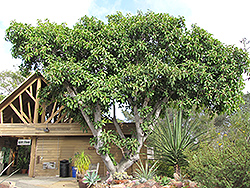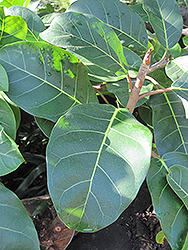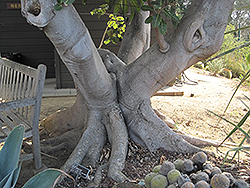Fri & Sat 8am - 8pm
Sun 8am - 7pm
Anytown, USA 12345
fax: 261.787.0463
e-mail: info@successgc.com


Plant Finder

Height: 40 feet
Spread: 60 feet
Sunlight:
![]()
![]()
Hardiness Zone: 10a
Other Names: Rock Fig, Lagos Rubbertree
Description:
Primarily grown for foliage, with huge, oval shaped leaves; in frost free areas this variety can grow quite large; can be maintained by pruning, or as a house or patio plant in colder climates; a wonderful landscape accent tree
Ornamental Features
Giant-leaved Fig has attractive dark green foliage with chartreuse veins on a tree with an oval habit of growth. The large glossy oval leaves are highly ornamental and remain dark green throughout the winter. The fruits are showy chartreuse pomes with lemon yellow overtones, which are displayed from early summer to mid fall. The fruit can be messy if allowed to drop on the lawn or walkways, and may require occasional clean-up. The smooth dark gray bark adds an interesting dimension to the landscape.
Landscape Attributes
Giant-leaved Fig is a multi-stemmed evergreen tree with a shapely oval form. Its average texture blends into the landscape, but can be balanced by one or two finer or coarser trees or shrubs for an effective composition.
This tree will require occasional maintenance and upkeep, and is best pruned in late winter once the threat of extreme cold has passed. It is a good choice for attracting birds to your yard, but is not particularly attractive to deer who tend to leave it alone in favor of tastier treats. Gardeners should be aware of the following characteristic(s) that may warrant special consideration;
- Insects
Giant-leaved Fig is recommended for the following landscape applications;
- Accent
- Shade
- Hedges/Screening
- Container Planting
Planting & Growing
Giant-leaved Fig will grow to be about 40 feet tall at maturity, with a spread of 60 feet. It has a low canopy with a typical clearance of 5 feet from the ground, and should not be planted underneath power lines. It grows at a fast rate, and under ideal conditions can be expected to live to a ripe old age of 100 years or more; think of this as a heritage tree for future generations!
This tree does best in full sun to partial shade. It does best in average to evenly moist conditions, but will not tolerate standing water. This plant should not require much in the way of fertilizing once established, although it may appreciate a shot of general-purpose fertilizer from time to time early in the growing season. It is not particular as to soil type or pH. It is highly tolerant of urban pollution and will even thrive in inner city environments. Consider applying a thick mulch around the root zone in winter to protect it in exposed locations or colder microclimates. This species is not originally from North America, and parts of it are known to be toxic to humans and animals, so care should be exercised in planting it around children and pets.
Giant-leaved Fig is a fine choice for the yard, but it is also a good selection for planting in outdoor pots and containers. Because of its height, it is often used as a 'thriller' in the 'spiller-thriller-filler' container combination; plant it near the center of the pot, surrounded by smaller plants and those that spill over the edges. It is even sizeable enough that it can be grown alone in a suitable container. Note that when grown in a container, it may not perform exactly as indicated on the tag - this is to be expected. Also note that when growing plants in outdoor containers and baskets, they may require more frequent waterings than they would in the yard or garden.


